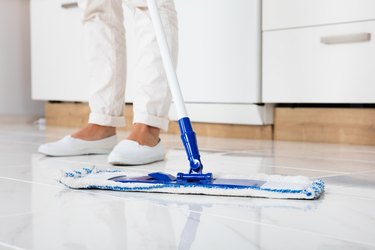
In an era where people are keen to create homemade household cleaning products, ammonia is not surprisingly the new cool kid on the block. This affordable, easy-to-use product has legions of fans who swear its efficacy on everything from streak-free windows to gleaming ovens. For some odd reason, it has the reputation of being natural, but it's important to understand how toxic ammonia can be, too.
What Is Ammonia?
Video of the Day
It's essentially one part nitrogen to three parts hydrogen, according to Science Mag. It's a fuel, a natural resource and it's incredibly toxic if you don't work with it safely.
Video of the Day
You must use gloves, as even undiluted household ammonia will cause burns. Eye protection is wise. You must have a well-ventilated home to use ammonia because its fumes are toxic. Never, ever combine it with bleach, as it becomes even more toxic. People who have breathing issues, young children and the elderly should all not be present during ammonia use and should not return to the space until all residual fumes have vanished.
So Why Use Ammonia?
Many things are harmful in life — but, used safely, they're advantageous.
The reality is most household cleaners use some degree of ammonia. Once diluted, it's still among the most effective products out there. It's an incredible degreaser and is fantastic for removing buildup on things like tile. Plus, it's as cheap as it gets. A bottle might set you back five bucks, but with the incredibly low quantity used for chores, it may last you years.
Ammonia Floor Cleaner
When using ammonia for cleaning floors, you'll be surprised how much wax and dirt buildup it can remove. It's terrific on old vinyl, tiles and some people even use it for removing stains on concrete and carpeting!
- To clean tile and vinyl floors: A cup of ammonia added to 1/2 gallon of water should remedy most scummy old tiles. Wearing gloves, use a sponge and soft bristle brush for spot-cleaning wherever your mop isn't getting it done. While this is a great way to refresh a floor, it is not recommended for regular cleaning, because it's so effective and somewhat corrosive that it can damage tile floor sealants and discolor them if used too often. Instead, use it a couple times a year to give it a seasonal restorative cleaning to get rid of wax and grime buildup.
- To clean wood floor and engineered floors: While some sites will give tips for doing this, the reality is that it can dull or damage the finish on floors. Only do this if your floors are years and years old and the old haze of years or decades of wax have left your floors lackluster and sad. Some people use Windex and some other ammonia-based cleaners as a spray cleaner for floors, mopped up with a dry mop. Still, it's risky. The pH balance is acidic and is known to damage these sensitive surfaces.
- The best use? Removing old wax on any old flooring. Just mix according to the tile/vinyl advice above, but never let it sit on the floor. Clean it and dry it reasonably quickly, and only do so periodically, not regularly.
Final Thoughts
Ammonia is incredibly powerful and effective. Used properly, it can accomplish a lot in your home, but it's also extremely toxic. If you have pets and children, you may want to look for ready-made products that contain ammonia but are properly diluted to be safer for a family home. If you're restoring an old house, though, it can be fantastic for everything from concrete stain removal and mitigating mold to removing two decades of tile scum in the bathroom.